You’ve heard that creatine is a joke and only fills you up with water weight. That it turns your muscles to fat once you stop taking it. Or the worst of all, that creatine somehow makes you unhealthy.
That’s nice, for the out of shape people trying to validate their current level of fitness. But it completely ignores the facts.
More strength, faster recovery, less time between sets – creatine is a powerhouse. Don’t believe us? Well you don’t have to. Creatine supplementation is science-backed like no other, and we’ll point you towards the correct information in this guide.
Best creatine sneak peak:
- Transparent Labs Creatine HMB – Best creapure creatine based on purity and innovation.
- Staunch Creatine Five – Second best multi-form creatine for difficulty absorbing.
- VitaDirect Creatine Monohydrate – Third best micronized creatine for buy-in-bulk.
What is Creatine and what does it do?
Creatine is a naturally occurring compound that your body makes as well as receives through dietary meat (2).
In the body, creatine maintains an energy reserve of ATP that can be used for both physical and cerebral exertion (3)(4).
Interestingly, this energy reserve is used relatively independent to standard mitochondrial respiration as seen in individuals with preexisting mitochondrial diseases (5).
The 7 types of creatine supplements
There are 7 different types of creatine that you should be familiar with as a consumer. The key difference between each one is the state of physical creatine or the compound it is bonded to.
Here is each type of creatine explained:
Creatine Monohydrate
Creatine monohydrate is the most widely used and studied form of creatine to date and most closely resembles our bodies own naturally synthesized creatine (30). The monohydrate in creatine monohydrate dictates that this form contains one part creatine to one part water on a molecular level (31).
Creapure Creatine
Creapure creatine is creatine monohydrate. The difference is that creapure creatine is manufactured by the company Alzchem in Germany which is considered to make the absolute highest quality available (32).
Micronized Creatine
Micronized means that the creatine monohydrate was put through a grinding process to make the powder more fine and easy to dissolve in water. This is good and bad. Good, because it helps the creatine to dissolve. But bad because quality Creapure creatine doesn’t require micronization as its in a crystaline state. Basically, the micronization process is a great way to salvage lower quality creatine monohydrate.
Microencapsulated Creatine
Microencapsulated creatine is one of the newest forms to come to market. It can be summarized as creatine monohydrate coated in a protein layer which allows it to dissolve in water easier (33). This is interesting, however completely unnecessary if you are using a quality source in the first place. It is also unclear as to how well this coated creatine becomes un-coated so that it may be utilized.
Buffered Creatine (Kre-Alkalyn)
Kre-Alkalyn is a form of creatine monohydrate that is buffered to a pH of 12 using patented methods. They claim that creatine is most stable at this pH and thus Kre-Alkalyn is a superior creatine vector though research isn’t as confident (34).
Creatine HCL
Creatine HCL takes the opposite approach to Kre-Alkalyn and delivers creatine with hydrochloric acid to reduce pH. This makes creatine HCL dissolve rapidly in water, require less water, less total creatine, and users report less water weight and bloat.
Free-acid Creatine
Free acid creatine is creatine in its most natural state. Many brands will mix free-acid creatine with other types, like creatine HCL or creatine monohydrate. Its unclear as to how effective this form is.
Is creatine safe?
According to the JISSN as of 2017, yes, creatine is exceptionally safe.
These claims are for creatine monohydrate exclusively, and do not vouch for alternative forms of creatine with less extensive research performed (9).
Digging deeper, individuals with pre-existing renal (kidney) conditions should avoid creatine as a precautionary measure, despite a lack of recent correlating research (10).
How much Creatine should I take and when do I take it?
The standard dosage for creatine that we’ve seen across all studies ranges from 4 to 6 grams.
We prefer the classic 5 grams per day dosage, with slightly less or lighter women.
While creatine can be taken at any time, it appears that post workout with food is most effective (30). There is a noticeable increase in total muscle glycogen storage during this time (31).
Top 10 Creatine Supplements
Our expert curators have provided the following creatine ranking to help you find the best creatine powder for your needs.
Ranking factors:
- Easily dissolving and highly bio-available creatine.
- No heavy metals or toxins detected.
- Personally rated by our review staff.
- Well-rated by the bodybuilding community.
- Cross-comparison to other brands.
To make it to our list, creatine supplements must pass all the above tests. To rank well on our list, creatine supplements must out-perform other products that made the cut.
#1 Creatine HMB
Best for: athletes seeking the most effective Creapure® creatine per serving.
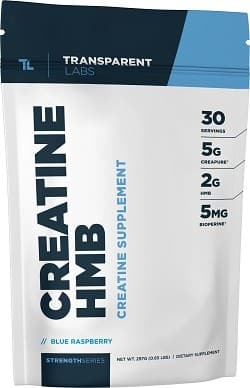
When all is said and done, there can be only one creatine choice for: building as much muscle as possible, getting a quality sourced product and getting a good value.
What we liked:
- Highest purity Creapure® creatine.
- Added HMB for muscle support.
- Zero artificial sweeteners / dyes.
- Best reviewed creatine powder.
What we disliked:
- Costs more than economy-priced creatine.
- Only available from brand website.
For regular creatine users and new users alike, Creatine HMB is a solid buy. There is no loading required, and you will feel this creatine’s effects in a much shorter time compared to lower-quality brands.
Typically, creatine monohydrate can cause a stomach ache on an empty stomach – but we didn’t run into that problem with Creatine HMB.
Compared to other creatine products, Creatine HMB provided us the most reliable strength and energy increases when taken on a daily basis.
#2 Staunch Creatine FIVE
Best for: athletes that don’t absorb creatine monohydrate well.
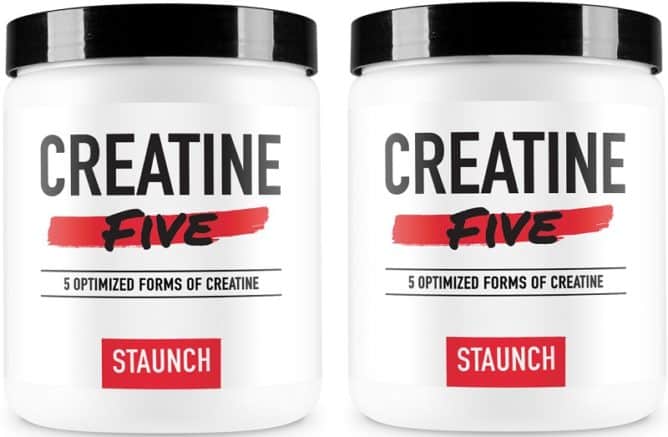
Staunch Creatine FIVE dissolves incredibly fast, provides multi-form creatine and is reasonably priced.
What we liked:
- Contains 5 grams of multi-sourced creatine.
- Dissolves quickly and flavored well.
- Multi-source ideal for sensitive stomachs.
What we disliked:
- Contains sucralose and artificial flavors.
Whats in Creatine FIVE?
Staunch Creatine 5 contains: 2 Grams MagnaPower Magnesium Creatine Chelate, 2 Grams Creatine Monohydrate, 330 mg Tri-Creatine Malate, 330 mg Creatine Pyruvate and 290 mg Creatine Anhydrous.
If you read our intro to creatine supplements above, then you know that we are die-hard creatine monohydrate fans. Despite this, Staunch has paved their way onto our rankings due to overwhelming positive reviews. If you don’t always stomach creatine monohydrate well, this is your best bet.
#3 VitaDirect Creatine Monohydrate [100 servings]
Best for: building muscle and strength on a budget with micronized creatine.
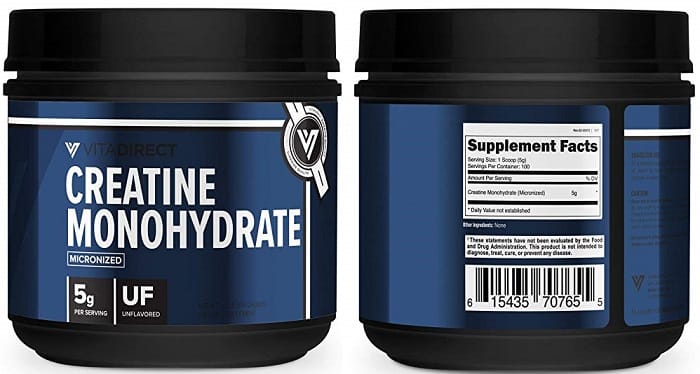
Trusted value brands are important in the creatine world, and VitaDirect is the top rated.
What we liked:
- Very economically priced.
- No side effects or stomach discomfort.
- Comes in 100 serving tubs.
- Available on Amazon.
What we disliked:
- Doesn’t contain Creapure® creatine.
- Slightly lesser known brand, less total reviews.
VitaDirect’s Creatine Monohydrate comes in 100 serving tubs and is available on the cheap ($13) via Amazon Prime. While taking this micronized creatine, we didn’t experience any stomach discomfort or other side effects you’d typically worry about with less-expensive brands.
If you prefer to get extra benefits from your creatine like added BCAAs, glutamine, electrolytes, etc. – this isn’t it. But if you want a straight-forward micronized creatine monohydrate, this is the one. There are zero fillers, dyes, flavors or preservatives – just 100% creatine monohydrate in a tub.
VitaDirect Bulk Creatine Monohydrate#4 Muscletech Cell-Tech Hard-Gainer Creatine
Best for: Young hard-gainers who need calories in their creatine supplement.
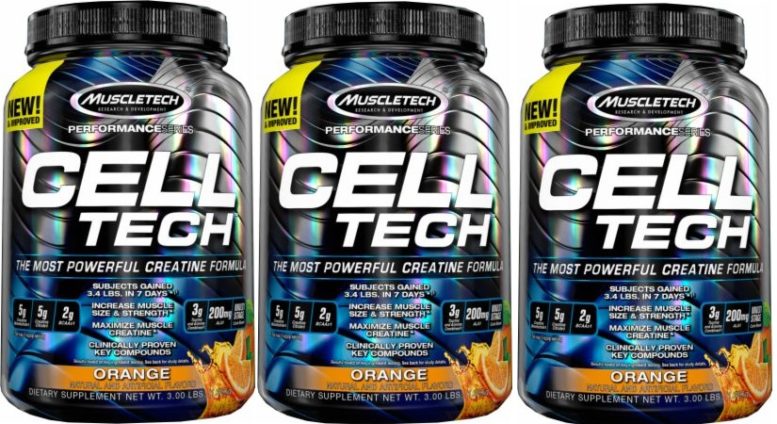
Muscletech’s Cell-tech is a living legend, and definitely deserves to be included on this ranking of the best creatine supplements.
What we liked:
- Historically a great creatine.
- Contains sugar for increased uptake (pro/con).
- Tastes fantastic.
What we disliked:
- Lots of additives.
- Poor macro sources, loaded with sugar.
- Only 2.5 grams creatine monohydrate.
What makes Cell-Tech different from other creatine supplements, is that they combine their creatine with 16 grams of carbohydrates. This allows you to easily take Cell-tech creatine without food, and still get really good absorption (since spiking your insulin significantly aids creatine uptake).
Personally, we still prefer to take our TL or Staunch creatine with some food, or alongside some sugary grape juice, apple juice, or OJ. But we’ve got to give credit where credit is due… Cell-Tech is one of the few things that Muscletech has done very, very, very right.
Get Muscletech Cell-Tech#5 Optimum Nutrition Micronized Creatine Monohydrate
Ideal for: Quality sourced micronized creatine available at GNC, vitamin Shoppe, and other retailers.
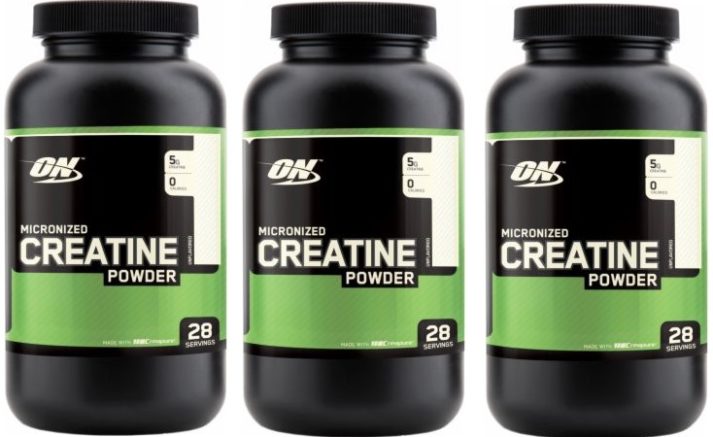
Optimum Nutrition’s Micronized Creatine Powder is one of the oldest and most trusted plain creatine products.
What we liked:
- Pure and straight forward.
- Micronized for easily dissolving.
- Widely available creatine.
What we disliked:
- Doesn’t use Creapure® creatine.
Optimum Nutrition’s Micronized Creatine Monohydrate is one of the easiest and least expensive ways to supplement with creatine. It may not be the best performing, but it is widely economical and reliable.
We recommend taking Micronized creatine alongside food or carb-containing drinks to enhance uptake for long-term success.
Get Optimum Nutrition Micronized Creatine#6 Muscletech Platinum 100% Creatine
Ideal for: Value chasers loyal to the Muscletech brand who just want a pure creatine monohydrate powder.
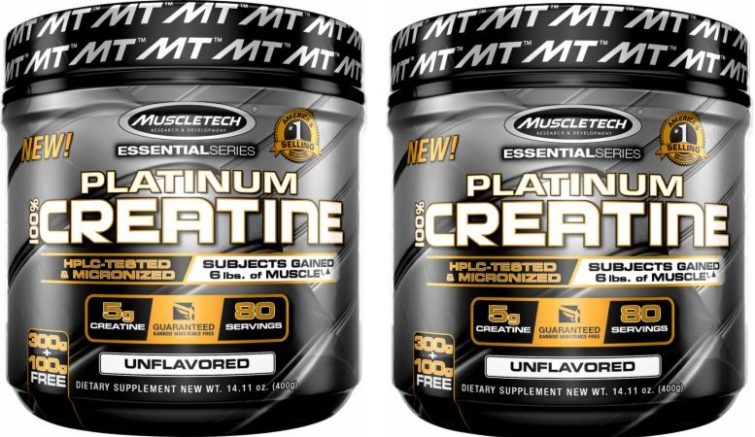
Muscletech offers many different creatine products, but Platinum 100% Creatine displays the greatest value.
What we liked:
- Inexpensive and available in bulk-sizes.
- Servings based on 5 gram serving size.
- Unflavored available for avoiding artificial flavors.
What we disliked:
- Could be less expensive for such a big brand.
- Aggressive / Flashy advertising.
Platinum 100% creatine is essentially Muscletech’s answer to Optimum Nutrition’s Micronized Creatine. This is a pure value play, but for many athletes it will make sense due to on-demand retail availability.
Platinum 100% Creatine uses micronized creatine monohydrate and is a solid option for most.
Get Muscletech Platinum 100% Creatine#7) EFX Kre-Alkalyn Creatine
Ideal for: athletes seeking pH alkaline creatine options.
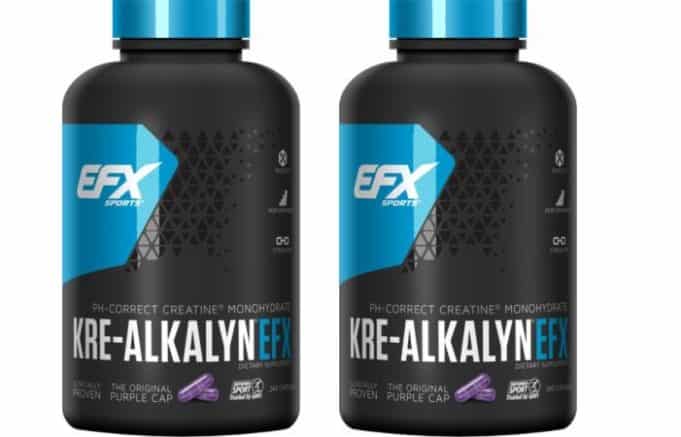
Kre-Alkalyn is a buffered form of creatine monohydrate distributed by EFX.
What we liked:
- Working towards innovating creatine.
- 1.5 grams creatine which is a lot for ‘specialties’.
What we disliked:
- Not the best research backing.
- Not 5 grams creatine monohydrate per serving.
- On market for a while, still low dose.
EFX’s argument on Kre-Alkalyn:
Research suggests that creatine monohydrate absorbs best at pH in and around 7 (neutral pH). However, upon ingesting creatine supplements, the creatine must first pass through the stomach’s acidic domain with a pH as low as 2.
Such drastic pH differentiations can alter a portion of creatine molecules to be non-functional. In addition, acidity can ‘travel’ with the creatine preventing the optimal pH of 7 from being reached.
The theorized solution to this problem, is buffering the creatine molecule so that pH of 7 is guaranteed. In turn, this facilitates a much greater uptake of creatine in the monohydrate form. Theoretically this is a great idea, and many guys say Kre-Alkalyn works amazing for them; but others have mentioned little effect.
Get EFX Kre-Alkalyn Buffered Creatine#8 Controlled Labs Green Might Creatine
Ideal for: athletes seeking energy-enhanced creatine monohydrate.
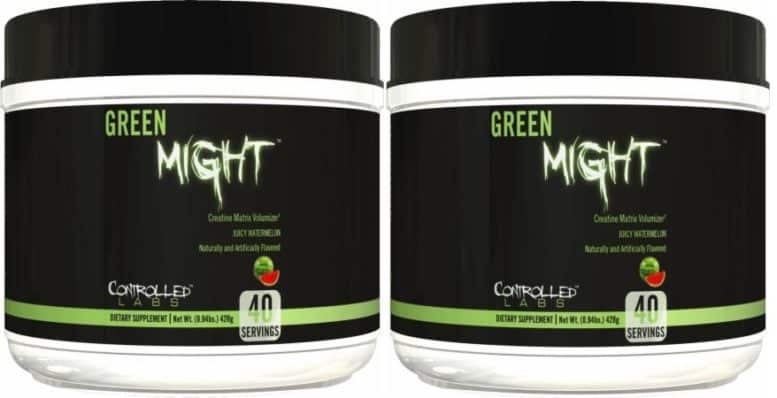
Green Might was formulated to contrast Green Magnitude using creatine monohydrate with a few value additions.
What we liked:
- Contains theobromine for energy
- Taurine to improve usage
- 5 grams creatine monohydrate
What we disliked:
- Doesn’t use Creapure®
- Artificial flavors and sucralose
The first Controlled Labs creatine we tried back in the day was Green Magnitude, an alternative blend to creatine monohydrate. Needless to say, we’re happy to see the release of Green Might harnessing the unrivaled power of tested and true creatine monohydrate.
Green Might contains added taurine, pomegranate, tart cherry and cocoa bean extract – offering a unique option in the creatine marketplace.
Get Controlled Labs Green Might#9 Kaged Muscle C-HCL Creatine HCL
Best for: Kris Gethin fans seeking a low-bloat creatine HCL.
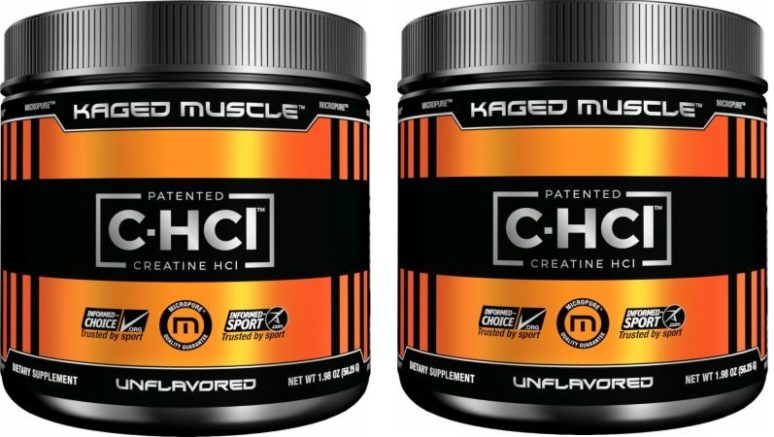
Kaged Muscle C-HCL is similar to other creatine hydrochloride brands, but backed fitness influencer Kris Gethin.
What we liked:
- ‘Uncompromising quality and purity’
- Reasonably priced for creatine HCL
What we disliked:
- A bit oversold.
- Could have a higher dosage.
No matter how great creatine powders get, there will always be a demand for creatine in pill form. In order to minimize the quantity and size of pills required – we prefer to reach for creatine HCL pills.
Kaged Muscle makes a great option in this case, with their C-HCL creatine.
For C-HCL, each serving is 750 mg which requires one pill. When we take creatine HCL though, we prefer around 1,500 mg on the daily or 3,000 mg if we haven’t been taking creatine consistently.
If regular creatine monohydrate has the habit of upsetting your stomach or causing serious gut bloating, then these creatine HCL pills may be a good option for you.
Get Kaged Muscle Creatine HCL#10 Universal Nutrition Creatine Chews
Best for: super-easy to take creatine monohydrate in chewable form.

Optimum Nutrition makes an interesting vector for creatine monohydrate – chews.
What we liked:
- Unique option for creatine use.
- 5 grams creatine per 4 chews.
What we disliked:
- Would rather just take powder.
Last on our list, we have good old creatine chews by Universal Nutrition. In this product, Universal Nutrition uses Creatine Monohydrate, 5 grams per serving in total, which requires 4 chews.
If you can’t do pills and aren’t too fond of powders either- then this is your last remaining option for creatine supplementation.
In addition to the creatine, there is about 4 grams of carbohydrates per serving in Universal Nutrition’s creatine chews.
Get Universal Nutrition Creatine ChewsTop 3 reasons to take creatine
#1 Lift More Weight with Creatine
By far, the most notable benefit to creatine supplementation is its ability to increase strength quickly (11). This appears to be most prevalent in bodybuilding and powerlifting type exercises, as we’ll cover below.
We separated creatine’s effect on strength based on upper body and lower body as previous research was on-edge between the two.
Our solution was to cover research performed recently, since 2014.
Lower Body Strength Gains
According to a recent meta-analysis covering 60 studies, creatine supplementation does increase lower body strength (12).
This strength increase spans across all the muscles of the lower body.
Notable strength increases include:
- Athletes supplementing with creatine achieved greater 1RM squats after performing complex training protocols (13).
- Shocking results appear in a Western Washington University study were creatine and electrolyte supplemented athletes increased 1MR squat strength by 13.4% over six weeks (14).
So yes, you’ll squat more weight with creatine than without it.
Upper Body Strength Gains
Having a strong squat is cool, but the bench press is what really gets the ladies. And guess what – creatine has been found to increase your bench press 1RM faster than not supplementing (15).
Notable strength increases include:
- Athletes receiving creatine monohydrate continued to break their bench press 1RM despite being exhausted from aerobic exercise, compared to non-supplemented groups who merely maintained their 1RM (16).
- Participants receiving 4 grams of creatine per day increased their 1RM by 4.7% over one month (17).
- Athletes supplementing with creatine and whey protein increased their upper-body strength by 178% more than the only-whey-protein group over six weeks (18).
So yes, if you begin taking creatine and your lifting partner doesn’t – you’ll overtake him within no time on the bench press and claim all that salty glory.
#2 Increase endurance and training volume with Creatine
Exercise volume is important for both muscle hypertrophy and endurance goals like (19).
Creatine has been found to improve total sets, time-trial performance, and agility in many studies; but it is not nearly as clear-cut as strength gain and muscle growth stimulation. So, let us explain.
Creatine can increase total reps and quality of sets
- Male and female participants performed the leg press after receiving a single dosage of creatine, both groups’ increased total reps in comparison to placebo, with females displaying a greater advantage with creatine (20).
Creatine can improve mental and physical agility
- During plyometric training, participants supplementing with creatine improved their sprint and jump performance greater than control and placebo groups (21).
- Elite soccer players were able to maintain greater jumping performance over time with creatine supplementation by 98% compared to non-supplementing players 50% (22). This suggests that creatine maintains strength despite cardio exhaustion.
Creatine may improve low-intensity cardio over time
The data on cardio is less clear:
- For starters, athletic women taking creatine and performing HIT exercises for 4 weeks did not display a statistical advantage over their non-supplementing counterparts (23). Noted though, was the insane effectiveness of HIIT training as a whole.
- This no-effect trend was also seen in amateur soccer players who consumed 20 grams of creatine monohydrate for 7 days, and then simulated soccer performance (24).
- However a submaximal endurance test with athletes receiving 5 grams of creatine per day showed positive results (25). In it, participants receiving creatine had a calmer heart rate, and exhibited greater endurance compared to the placebo group not receiving creatine.
This indicates to us that creatine improves strength-of-impulse as well as low-intensity exercise performance. However events where oxygen is completely depleted, creatine cannot improve endurance, only small bouts of strength.
#3 Build More Muscle with Creatine
Building more muscle is a clear goal for the majority of men, whether training or not training (26).
Creatine is one of the most popular options for increasing the rate of muscle growth, and for good reason:
All of which commonly result in greater lean muscle mass in comparison to individuals undergoing the same training protocol without creatine supplementation (29).
Note: Basically all of the studies in the strength and performance segments correlated creatine supplementation with lean muscle mass increase.
How to increase creatine levels naturally
While creatine is made up of the amino acids: arginine, glycine and methionine – it appears that arginine is the key limiting step for creatine synthesis in the body (6).
Creatine not synthesized naturally by the body is safely obtained through diet via animal products and supplemental creatine powder.
How long is creatine stored in the body?
Dietary creatine from supplemental ingestion is stored relatively efficiently for later use and depletes in a slowing rate (meaning you lose more on day 1, than on day 2).
This is roughly a 15% loss after day one, compared to subsequent 5% losses thereafter (7).
This is why most athletes and bodybuilders supplement with creatine on a daily basis, but timing in reference to exercise really doesn’t matter.
Getting Creatine Monohydrate to Dissolve
Monohydrate is the most popular form of creatine for many amazing reasons. But man, this stuff can be a little difficult when you try to get it to dissolve if you don’t know what your doing. And, we want it to fully dissolve since that’s necessary for full assimilation.
Now first, what exactly is ‘dissolved’ you may ask? Stupid question? No. See, a lot of guys confuse ‘in suspension’ with ‘dissolved’. When you stir up your creatine and none is on the bottom of the glass but the liquid looks cloudy and gritty, that is ‘in suspension’. When you stir your creatine until there is no visible powder and the clarity of the liquid returns with the exception of dyes; that is ‘dissolved’.
So, how do you get it properly dissolved when it clearly doesn’t want to?
Easy, take creatine the way it was originally taken back in the day – heat it up a bit! So, after your post workout meal go ahead and heat up a bit of water. Once it’s warm (doesn’t need to boil by any means) carefully transfer it to a cup and add in your creatine powder. From there, stir until it’s properly dissolved which won’t take too long. Now, you are good to go and will both get better uptake as well as less gas/bloating if that was an issue for you.
Its important to point out that this is not the case for 95% of guys that take monohydrate. Unless you have had trouble in the past, you should be good downing monohydrate in standard room temperature water, with or without protein/BCAAs. Just make sure you have plenty of water, which helps the whole process!
Review of the ranking:
Table of Contents
- What is Creatine and what does it do?
- Top 10 Creatine Supplements
- #1 Creatine HMB
- #2 Staunch Creatine FIVE
- #3 VitaDirect Creatine Monohydrate [100 servings]
- #4 Muscletech Cell-Tech Hard-Gainer Creatine
- #5 Optimum Nutrition Micronized Creatine Monohydrate
- #6 Muscletech Platinum 100% Creatine
- #7) EFX Kre-Alkalyn Creatine
- #8 Controlled Labs Green Might Creatine
- #9 Kaged Muscle C-HCL Creatine HCL
- #10 Universal Nutrition Creatine Chews
- Top 3 reasons to take creatine
- #1 Lift More Weight with Creatine
- #2 Increase endurance and training volume with Creatine
- #3 Build More Muscle with Creatine
Like what we provide? Like us on Facebook! If you have any comments, questions, or concerns – you can drop us a line below. Thanks for visiting.
